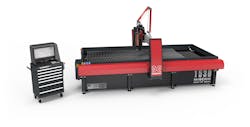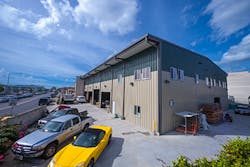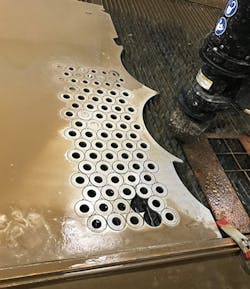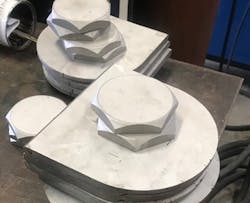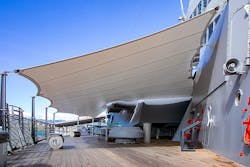Waterjet Machining Makes One Shop an All-Weather Choice
In Hawai’i, the tropical heat can turn into a thunderous downpour in a matter of seconds. Whatever the weather, with the help of their MAXIEM® abrasive waterjet cutting table, Tropical J’s is designing and crafting custom awnings for the Aloha State.
Tropical J’s began designing hand-crafted, tropical-print, and hand-held umbrellas in 1989. The company grew quickly and started producing an entire array of quality awnings as well as other outdoor products.
Today, with 25 employees and a 16,000-sq. ft. manufacturing floor, Tropical J’s services the island’s commercial and residential markets. “At any given time, we have 50-plus ongoing projects from concept design and sales to manufacturing, installation, and recovers that are either uniquely our own, or are a vision presented from architects and other designers that they would like to see come to fruition,” said Jordan Barnes, who heads up the design and sales side of Tropical J’s Incorporated.
“Some of our most notable current projects include large-scale suspension shade systems for an up-and-coming outdoor luxury mall that spans over long corridors, as well as their independent store front awnings, market umbrellas, and furniture pieces to adorn the walkways,” Barnes continued.
Recently, using a MAXIEM 1530 abrasive waterjet, Tropical J’s completely redesigned the awning and its supports for a sunshade on the USS Missouri. The USS Missouri is the Iowa-class battleship that was the stage for the Japanese surrender to the United States on September 2, 1945, bringing the Second World War to its official close. Currently, the battleship is moored at Battleship Row in Pearl Harbor as part of the memorial there.
“We’re very proud and honored to have recently recovered the historic surrender deck of the USS Missouri, for which we will be doing a presentation during the 2018 Industrial Fabrics Association International Expo this year,” Barnes said.
Tropical J’s acquired the OMAX abrasive waterjet in 2017 as a way to streamline its business. “Hawai’i can feel like a small island, especially if your business model includes manufacturing,” Barnes observed. “Having used a plasma cutting table for years, we were restricted by its material thickness capabilities, and the cut quality was laborious to clean up manually with grinders.” Having to outsource thicker metals to job shops cost the company time and money.
The solution was to integrate the MAXIEM 1530® with an A-Jet® cutting head and a 600-lbs. abrasive feed hopper into their shop. The MAXIEM provides an ample cutting envelope, coupled with OMAX® ingenuity and power.
The A-Jet accessory allows Tropical J’s to produce beveled edges, angled sides, and countersink with no additional machining.
When Tropical J’s bought the waterjet, they took advantage of the training services at OMAX’s Kent, Wash., campus, where they picked up all the tips and tricks shops may need to be productive on the new machine. “It’s a great investment and critical to understanding the maintenance and full capabilities of the machine,” Barnes said.
“We design all our custom structures from scratch and really have started incorporating the artistic cutting possibilities into our framework. Our customers love the option of being unique and incorporating branding into their structures, whether it’s motifs or logo work,” Barnes said.
With an abrasive waterjet, it doesn’t matter if a customer asks for plastic, metal, or glass parts – you can do it all. It’s this type of time-conscious versatility that has allowed Tropical J’s to expand their reach even further, winning jobs like the USS Missouri project. “We absolutely love the accuracy and tight tolerances that set us apart from the competition, with clean brackets, tabs, and plates. The freedom of having this technology at our fingertips has completely eliminated dangerous time delays in relying on others.”
“Every day, we realize a new potential for ROI with our cutting capabilities,” Barnes said. “Other local companies heard through the grapevine of our new setup and we started realizing a nice ROI on our purchase. We sell cut time like a commodity, and aim to keep the machine running as often as possible.”
